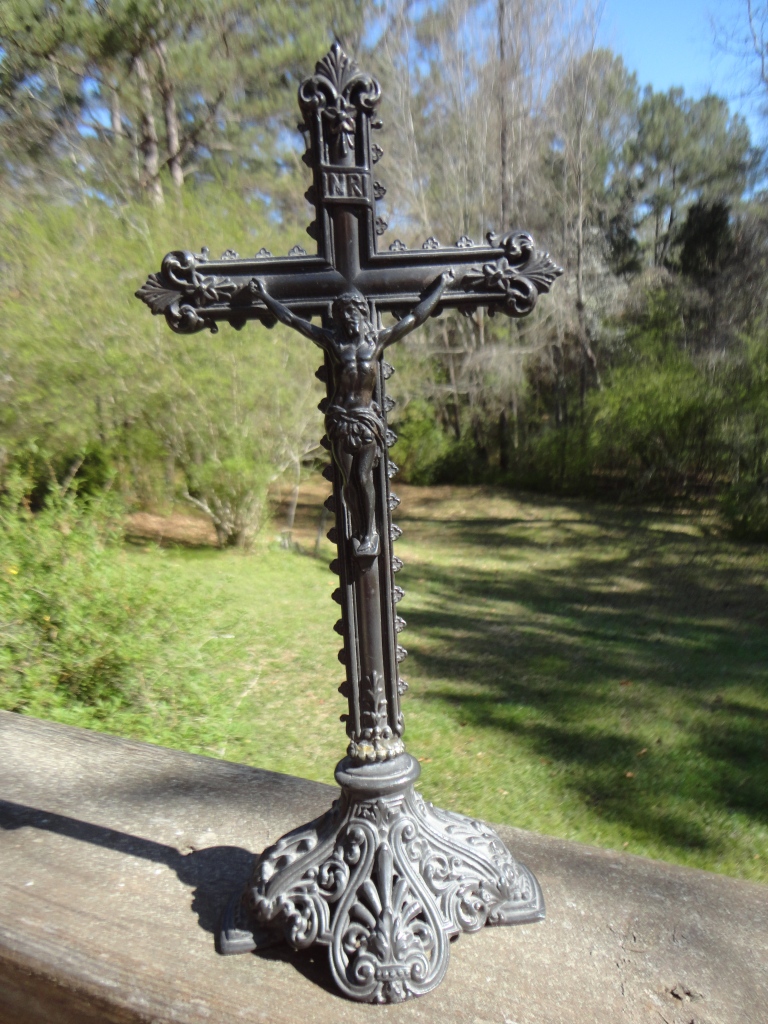It’s officially Spring!! Looking out my office window the Carolina sky is a pale blue, the sun is shining, trees are starting to leaf … and it was a brisk 30 degrees when I woke up! Not exactly spring temps. It’s warmer here than in Ohio where my sisters live, but not by much. But the robins are singing and there’s hope and promise for warmer weather.
Which ties in with what I’d started to write for last Monday’s post. I struggled with how to say what I wanted to get across, so I eventually put it aside. Maybe a week of fermenting has helped.
Sunday was the fourth Sunday of Lent, marking halfway to Easter. On Ash Wednesday I set up a little Lenten space to set the tone and mood for my daily meditations, nothing fancy, just a reminder of the season. As if the meditations themselves wouldn’t be reminder enough! The candles are from my Advent wreath, which aren’t only symbolic but also my being frugal. I mean, there’s still plenty of wick and wax left. The central candle is the one I used for my 12 Days of Christmas, so a transition of sorts from one liturgical season to the next. The metal crucifix belonged to my dad, and I wouldn’t be surprised if it once belonged to my grandparents. When my sisters and I shared family treasures after dad’s death, it came home with me.


The crucifix is probably brass. It’s heavy, dark, and somewhat ornate. Usually in another part of the house, I moved it to the kitchen nook for these weeks of Easter preparation. It brings back images of Lent when I was growing up, from my child’s perspective, a very somber experience. There were weekly Stations of the Cross, our choice of ‘giving ups’—usually candy—and either fish sticks or tuna casserole on Fridays because we couldn’t eat meat.
We entered this time of repentance on Ash Wednesday, stayed in this holding pattern for six weeks, then woke Easter morning with our new dresses, straw hats with elastic bands that cut into our necks, and new patent leather shoes we couldn’t wait to wear. I don’t remember witnessing or hearing my parents or grandparents, all of whom very devout Catholics, ever talking about the transformational experience of Lent. As much as I liked the rites and rituals of ashes and incense (still do), Lent didn’t feel like a season of preparation or building up to the joy of Easter. It just was.
On the other side of my chair is a small table with another crucifix that stays all the time. It’s called the Gift of the Holy Spirit, a gift from my former pastor when I was a youth minister. I noticed it in a Catholic bookstore and mentioned I’d never seen such a crucifix. He surprised me with it on my birthday a few months later.
This image of the Christ’s suffering is completely different than the other. It’s blond wood, the figure a silvery pewter, and instead of the corpus hidden in the darkness of the cross, it’s in the moment of death when Jesus commends his Spirit to God. The piece is visually lighter but not its essence. It doesn’t negate the horror of the crucifixion, but it also doesn’t stop there.
I’ve been honored to be with four different loved ones as they transitioned. Each time there was that moment when they were both here and in the Presence of Other, a very real liminal space. It’s that moment depicted in The Gift of the Holy Spirit.
This year I returned to the Lenten meditation incorporating Mary Oliver’s poetry. Each week’s prayer builds on the previous weeks’ meditations, there is the sense of moving toward something. I feel not only the weight of asking for mercy, but also the weightlessness of the coming grace of Easter.
Another meditation, Not by Bread Alone by Susan H. Swetnam, recounts the Prodigal Son, the wayward one always characterized by shame, remorse, maybe fear of rejection, maybe a touch of hutzpah as he trudges back to his father. What if it wasn’t hutzpah? This writer offers that hope propelled him to continue. While that may have been implied, I’ve never heard it expressed. The lessons were always about repentance on the son’s part, and forgiveness on the father’s. By adding this other emotion, the story changed.
Sunday the priest and deacon wore rose-colored vestments instead of purple ones. Like Gaudete Sunday during Advent, the color switch signifies the joy and sense of hope that Lent is almost over, and the joy and hope of what is to come.
During this season as I sit between the two crosses, a tableau of how I’ve always seen myself ‘sitting’ between pre-and post-Vatican II, I’m also sitting in the sunniest part of the house, the place where Spring enters. I’m comfortable here.


